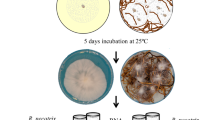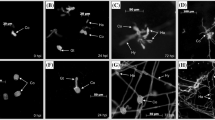Abstract
The root-rot fungus Heterobasidion annosum is a major pathogen of woody trees in temperate regions of the world. In this study, seedling root of Scots pine was used as an experimental model to investigate gene expression in conifer trees during challenge with H. annosum. Initial cellular and histochemical studies have established the systems and indicated the key sequence of events during the infection process. Also, to correlate histochemical observations with the time-dependent pattern of events in host gene expression, a transcriptome profiling of a selected set of host genes from a pine-root subtraction cDNA library was conducted. Differential screening of the subset of genes arrayed on nylon membrane with cDNA probes made from seedling roots infected for 1, 3, 7 and 15 days revealed a number of up-regulated genes [disease-resistance gene analog, antimicrobial peptide (AMP) gene homolog etc.] following inoculation. The results also showed strong expression of genes involved in cell defense and protein synthesis at the early stages of the infection (3–7 days) with a decline at late stages of infection (15 days). The decline in expression of key defense genes at late stages of infection correlated well with the period of vascular colonization and subsequent loss of root turgor. Northern analyses with two of the major induced genes (AMP homolog and disease-resistance gene analog) indicated a several-fold increase in host gene expression following infection. In addition, a particular single gene (thaumatin-like protein) was consistently expressed throughout the four sampling periods of the experiment. BlastX analyses revealed that the Scots-pine thaumatin-like gene shared 51–77% sequence homology with other thaumatin-like proteins in GenBank. The importance of these results in tree defense and use of conifer seedling root in host–parasite interaction in forest trees is discussed.







Similar content being viewed by others
References
Adams MD, Kelly JM, Gocayne JD, Dubnick M, Polymeropoulos MH, Xiao H, Merril CR, Wu A, Olde B, Moreno RF (1991) Complimentary DNA sequencing: expressed sequence tags and human genome project. Science 21:1651–1656
Asiegbu FO (2000) Adhesion and development of the root rot fungus (Heterobasidion annosum) on conifer tissues: effects of spore and host surface constituents. FEMS Microbiol Ecol 33:101–110
Asiegbu FO, Daniel G, Johansson M (1994) Defence related reactions of seedling roots of Norway spruce to infection by Heterobasidion annosum (Fr.) Bref. Physiol Mol Plant Pathol 45:1–19
Asiegbu FO, Johansson M, Woodward S, Huttermann A (1998) Biochemistry of the host-parasite interaction. In: Woodward S, Stenlid J, Karjalainen R, Huttermann A (eds) Heterobasidion annosum. Ecology, impact and control. CAB International, London, pp 167–193
Asiegbu FO, Nahalkova J, Choi W, Stenlid J, Dean R (2003) Analyses of selected expressed sequence tags (EST) from Heterobasidion annosum–Pinus sylvestris pathosystem. In: Laflamme G, Berube JA, Bussieres G (eds) Root and butt rots of forest trees. Tenth international conference on root and butt rots. Micromedia, Canada, pp 260–266
Botella MA, Coleman MJ, Hughes DE, Nishimura MT, Jones JDG, Somerville SC (1997) Map positions of 47 Arabidopsis sequences with sequence similarity to disease resistance genes. Plant J 12:1197–1211
Chang S, Puryear J, Cairney J (1993) A simple and efficient method for isolating RNA from pine trees. Plant Mol Biol Rep 11:113–116
Chou W-M, Kutchan T (1998) Enzymatic oxidation in the biosynthesis of complex alkaloids. Plant J 15:289–300
Cooke R, Raynal M, Laudie M, Grellet F, Delseny M, Morris PC, Guerrier D, Giraudat J, Quigley F, Clabault G, Li YF, Mache R, Krivitzky M, Gy IJ, Kreis M, Lecharny A, Parmentier Y, Marbach J, Fleck J, Clement B, Philips G, Herve C, Bardet C, Tremousaygue D, Hofte H (1996) Further progress towards a catalogue of all Arabidopsis genes: analysis of a set of 5,000 non-redundant ESTs. Plant J 9:101–124
Durst F, O’Keefe DP (1995) Plant cytochrome P450: an overview. Drug Metabol Drug Interact 12:171–178
Feuillet C, Schachermayr G, Keller B (1997) Molecular cloning of a new receptor-like kinase gene encoded at the Lr10 disease resistance locus of wheat. Plant J 11:45–52
Hodges CS (1969) Modes of infection and spread of Fomes annosus. Annu Rev Phytopathol 7:247–266
Hulbert SH, Webb GA, Smith SM, Sun Q (2001) Resistance gene complexes: evolution and utilization. Annu Rev Phytopathol 39:285–312
Kroj T, Rudd JJ, Nürnberger T, Gäbler Y, Lee J, Scheel D (2003) Mitogen-activated protein kinases play an essential role in oxidative burst-independent expression of pathogenesis-related genes in parsley. J Biol Chem 278:2256–2264
Kwak JK, Kim SA, Hong SW, Nam HG (1997) Evaluation of 515 expressed sequence tags obtained from guard cells of Brassica campestris. Planta 202:9–17
Lee CM, Lee YJ, Lee MH, Cho TJ, Hahn TR, Cho MJ, Sohn U (1998) Large scale analyses of expressed genes from the leaf of oil seed rape (Brassica napus L.). Plant Cell Rep 17:930–936
Lim CO, Kim HY, Kim MG, Lee SI, Chung WS, Park SH, Hwang I, Cho MJ (1996) Expressed sequence tags of Chinese cabbage flower bud cDNA. Plant Physiol 111:577–588
Liu J, Hara C, Umeda M, Zhao Y, Okita TW, Uchimiya H (1995) Analyses of randomly isolated cDNAs from developing endosperm of rice (Oryza sativa): evaluation of expressed sequence tags, and expression levels of mRNA. Plant Mol Biol 29:685–689
Marcus JP, Green JL, Goulter KC, Manners JM (1999) A family of antimicrobial peptide is produced by processing of a 7S globulin protein in Macademia integrifolia kernels. Plant J 19:699–710
Parker JE, Coleman MJ, Szabo V, Frost LN, Schmidt R, van der Biezen EA, Moores T, Dean C, Daniels MJ, Jones JD (1997) The Arabidopsis downy mildew resistance gene RPP5 shares similarity to toll and interleukin-1 receptors with N and L6. Plant Cell 9:879–894
Persans MW, Wang J, Schuler MA (2001) Characterization of maize cytochrome P450 monooxygenases induced in response to safeners and bacterial pathogens. Plant Physiol 125:1126–1138
Rauyaree P, Choi W, Fang E, Blackmon B, Dean RA (2001) Genes expressed during early stages of rice infection with the rice blast fungus Magnaporthe grisea. Mol Plant Pathol 2:347–354
Redfern DB, Stenlid J (1998) Spore dispersal and infection. In: Woodward S, Stenlid J, Karjalainen R, Huttermann A (eds) Heterobasidion annosum. Ecology, impact and control. CAB International, London, pp 105–124
Tagu D, Martin F (1995) Expressed sequence tags of randomly selected cDNA clones from Eucalyptus globulus-Pisolithus tinctorius ectomycorrhiza. Mol Plant Microbe Interact 8:781–783
Umeda M, Hara C, Matasubayashi Y, Li H, Liu Q, Tadokoro F, Aotsuka S, Uchimiya H (1994) Expressed sequence tags from cultured cells of rice under stressed conditions: analysis of transcripts of genes engaged in ATP-generating pathways. Plant Mol Biol 25:469–478
Walden AR, Walter C, Gardner RC (1999) Genes expressed in Pinus radiata male cones include homologs to anther-specific and pathogenesis response genes. Plant Physiol 121:1103–1116
Wang Z, Brown D (1991) A gene expression screen. Proc Natl Acad Sci USA 88:11505–11509
Wyrich R, Dressen U, Brockmann S, Streubel M, Chang C, Qiang D, Paterson AH, Westhoff P (1998) The molecular basis of C4 photosynthesis in sorghum: isolation, characterization and RFLP mapping of mesophyl and bundle sheath specific cDNAs obtained by differential screening. Plant Mol Biol 37:319–335
Zhu H, Choi S, Johnston AK, Wing RA, Dean RA (1997) A large insert (130 kbp) bacterial artificial chromosome library of the rice blast fungus Magnaporthe grisea: genome analysis, contig assembly and gene cloning. Fungal Genet Biol 21:337–347
Acknowledgements
This work was supported by grants from the Swedish Research Council for Forestry, Agriculture and Spatial Planning (FORMAS), Swedish Organization for International Cooperation in Research and Higher Education (STINT) and Carl Tryggers Stiftelse.
Author information
Authors and Affiliations
Corresponding author
Rights and permissions
About this article
Cite this article
Li, G., Asiegbu, F.O. Use of Scots pine seedling roots as an experimental model to investigate gene expression during interaction with the conifer pathogen Heterobasidion annosum (P-type). J Plant Res 117, 155–162 (2004). https://doi.org/10.1007/s10265-003-0140-4
Received:
Accepted:
Published:
Issue Date:
DOI: https://doi.org/10.1007/s10265-003-0140-4




